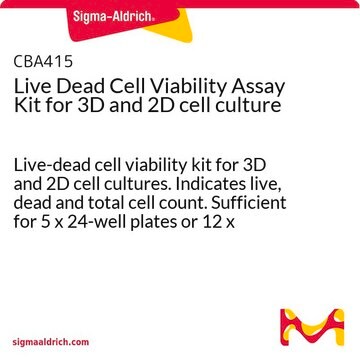Calcein-AM is a fluorescent dye used to stain live bacterial cells for flow cytometry application. Product 17783, Calcein-AM, is suitable for fluorescence and is at least 96.0% HPLC pure. For dyes that can stain bacteria but do not enter bacterial cells, you may find the products SCT126, BioTracker 510 Green C4(FM1-43) Synaptic Dye, and SCT127, BioTracker 640 Red C2(FM4-64) Synaptic Dye may be suitable.
17783
Calcéine AM
suitable for fluorescence, BioReagent, ≥90% (HPLC)
Synonyme(s) :
Acétoxyméthylester de calcéine, O,O′-Diacétate tétrakis(acétoxyméthyl) de calcéine, ester
Sélectionner une taille de conditionnement
Sélectionner une taille de conditionnement
About This Item
Produits recommandés
Gamme de produits
BioReagent
Niveau de qualité
Essai
≥90% (HPLC)
Fluorescence
λex 496 nm; λem 516 nm in 0.1 M Tris pH 8.0, esterase; Ca2+
Adéquation
suitable for fluorescence
Température de stockage
−20°C
Chaîne SMILES
CC(=O)OCOC(=O)CN(CC(=O)OCOC(C)=O)Cc1c(OC(C)=O)ccc2c1Oc3c(CN(CC(=O)OCOC(C)=O)CC(=O)OCOC(C)=O)c(OC(C)=O)ccc3C24OC(=O)c5ccccc45
InChI
1S/C46H46N2O23/c1-25(49)60-21-64-39(55)17-47(18-40(56)65-22-61-26(2)50)15-32-37(68-29(5)53)13-11-35-43(32)70-44-33(16-48(19-41(57)66-23-62-27(3)51)20-42(58)67-24-63-28(4)52)38(69-30(6)54)14-12-36(44)46(35)34-10-8-7-9-31(34)45(59)71-46/h7-14H,15-24H2,1-6H3
Clé InChI
XKFSBWQWNMZWFA-UHFFFAOYSA-N
Vous recherchez des produits similaires ? Visite Guide de comparaison des produits
Catégories apparentées
Description générale
Application
Code de la classe de stockage
11 - Combustible Solids
Classe de danger pour l'eau (WGK)
WGK 3
Point d'éclair (°F)
Not applicable
Point d'éclair (°C)
Not applicable
Équipement de protection individuelle
Eyeshields, Gloves, type N95 (US)
Faites votre choix parmi les versions les plus récentes :
Déjà en possession de ce produit ?
Retrouvez la documentation relative aux produits que vous avez récemment achetés dans la Bibliothèque de documents.
Les clients ont également consulté
Articles
Sigma-Aldrich presents a Biofiles on Detect, Visualize and Quantify Single Post-Translational Modifications
Tests sur cellules pour l'étude de la prolifération (BrdU, MTT, WST1), de la viabilité et de la toxicité cellulaires pour la recherche sur le cancer, la recherche en neurosciences et la recherche sur cellules souches.
Cell based assays for cell proliferation (BrdU, MTT, WST1), cell viability and cytotoxicity experiments for applications in cancer, neuroscience and stem cell research.
Nitric oxide (NO) as a signal transporter in neurons, endothelial cells and in the immune system.
Contenu apparenté
Step-by-step protocol for generating apical-out human gut organoids for microbiome, ADME/Tox, viral and gastrointestinal related disease research. See the complete organoid culture protocol.
-
Recommend fluorescent dyes for live bacterial cell sorting, especially those validated that the dye enters in bacteria and are not transferred to daughter cells.
1 answer-
Helpful?
-
-
What live cell dye (DNA non-binding) is recommended for staining live cells while ensuring that the cells remain viable after staining, particularly for bacterial cells? Would using DSMO be suitable, or is there an alternative stain recommendation?
1 answer-
Calcein AM may not be soluble in water. DMSO can be used as the solvent and there is no mention of solubility in water or alcohol. The free acid is soluble in water and ethanol. However, only DMSO is listed for the solubility of Calcein AM. Concerns about DMSO affecting bacteria viability may lead to a switch from the hexa ester to the free acid form. Maintaining a 1:500 dilution of DMSO in the staining solution is advisable to avoid potential viability issues.
Helpful?
-
-
What are the spectral properties of Calcein-AM, Product 17783?
1 answer-
The emission maximum for Calcein-AM is 516 nm, with excitation at 496 nm in 0.1M Tris pH 8.0 (following hydrolysis by esterase enzyme, bound to Ca(2+)).
Helpful?
-
-
What is the solubility of Calcein-AM, Product 17783?
1 answer-
Sigma tests the solubility of Product No. 17783 at a concentration of 10 mg/mL in dimethyl sulfoxide (DMSO).
Helpful?
-
-
What is the Department of Transportation shipping information for this product?
1 answer-
Transportation information can be found in Section 14 of the product's (M)SDS.To access the shipping information for this material, use the link on the product detail page for the product.
Helpful?
-
-
How is Calcein-AM, Product 17783, typically used?
1 answer-
Calcein-AM is a cell-permeant and non-fluorescent compound that is widely used for determining cell viability. In live cells the non-fluorescent calcein-AM is hydrolyzed by intracellular esterases into the strongly green fluorescent anion calcein. The fluorescent calcein is well-retained in the cytoplasm in live cells.
Helpful?
-
-
What is the appearance of Calcein-AM, Product No. 17783?
1 answer-
Product No. 17783 can be a film, oil, paste or solid.
Helpful?
-
-
Do the Scienceware® brand polypropylene products contain any leachable material?
1 answer-
Although Bel-Art does not specifically test their Scienceware® brand polypropylene products, they have no evidence of any problems with leachable material in the polypropylene.
Helpful?
-
Active Filters
Notre équipe de scientifiques dispose d'une expérience dans tous les secteurs de la recherche, notamment en sciences de la vie, science des matériaux, synthèse chimique, chromatographie, analyse et dans de nombreux autres domaines..
Contacter notre Service technique









